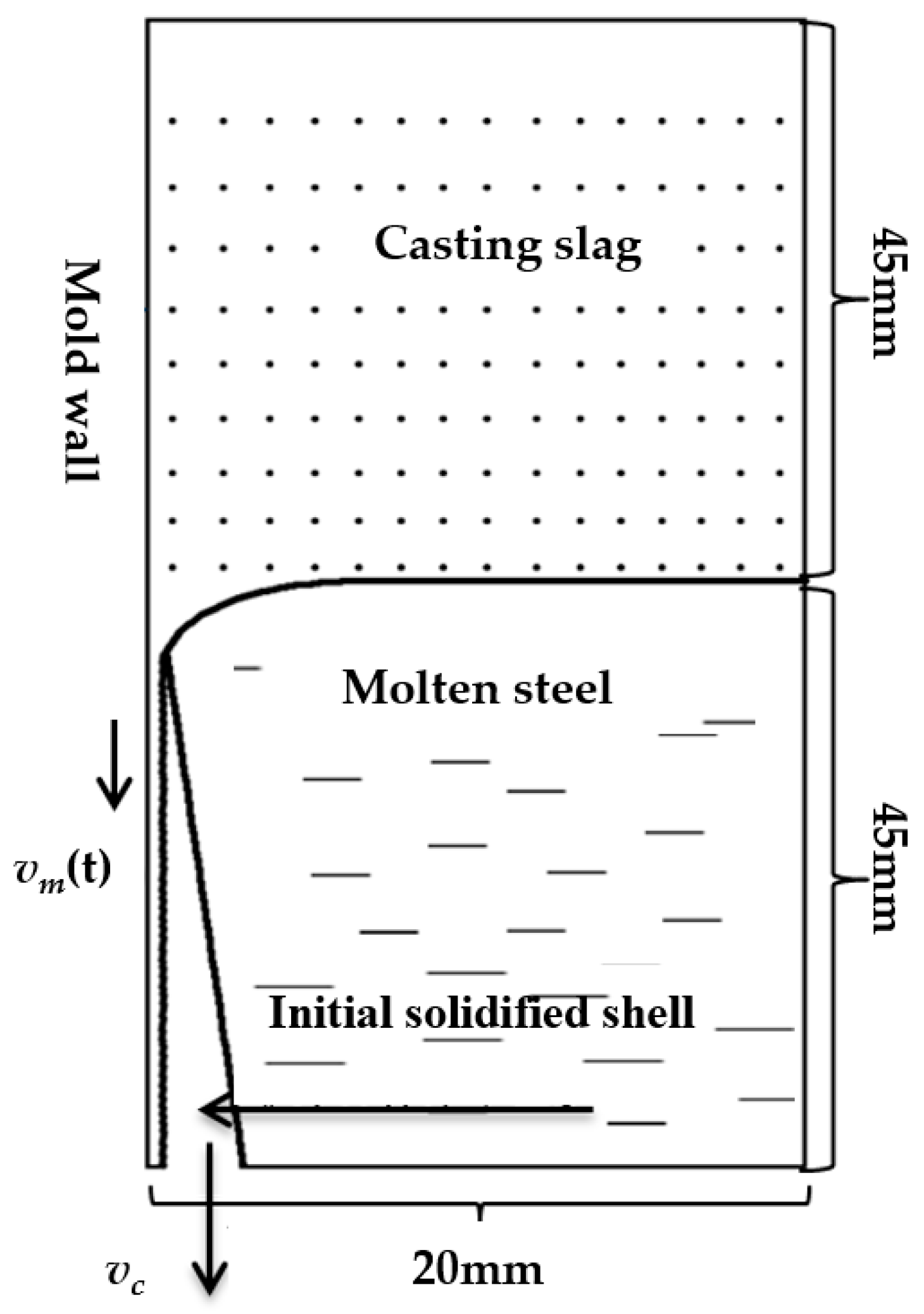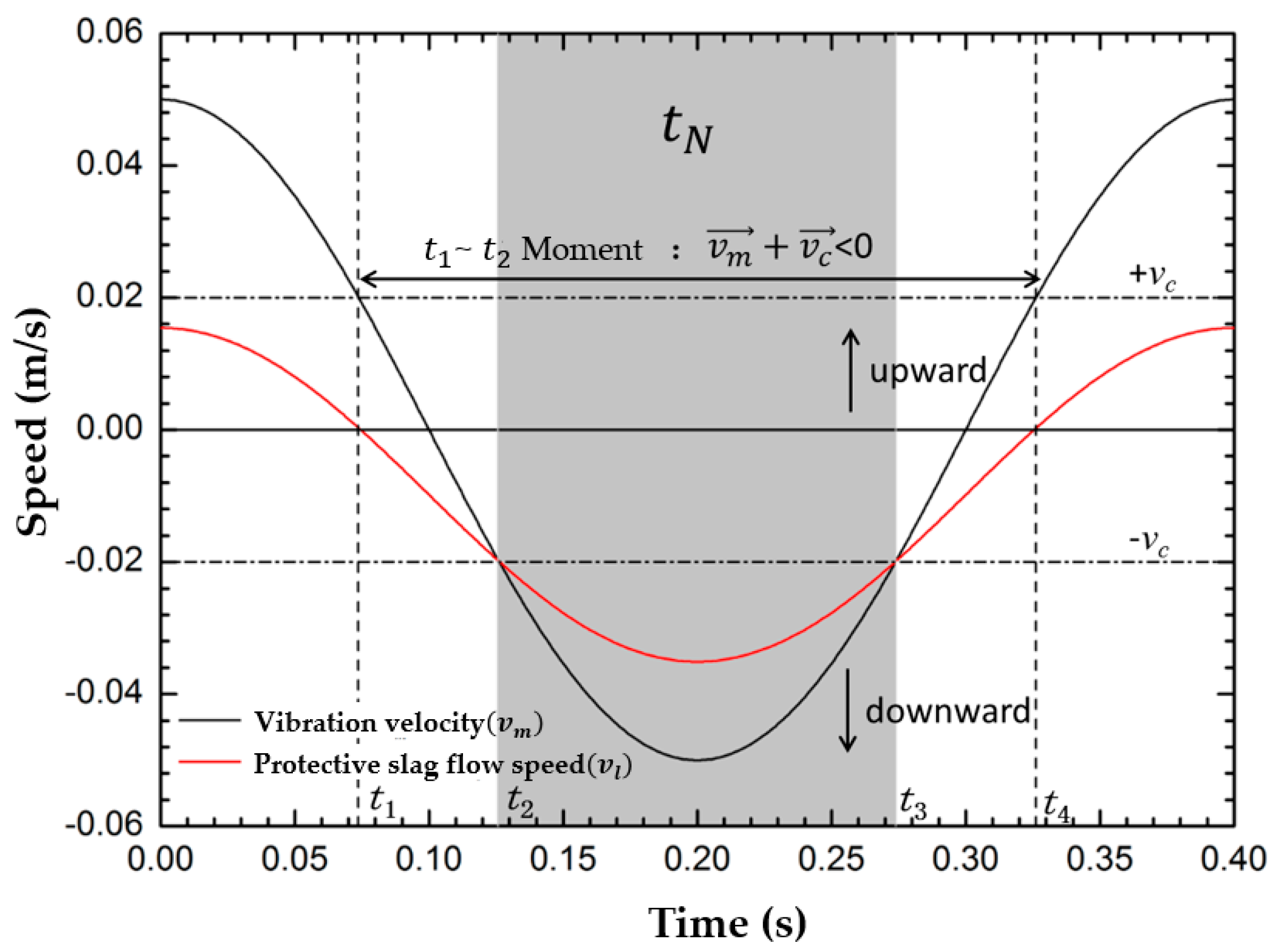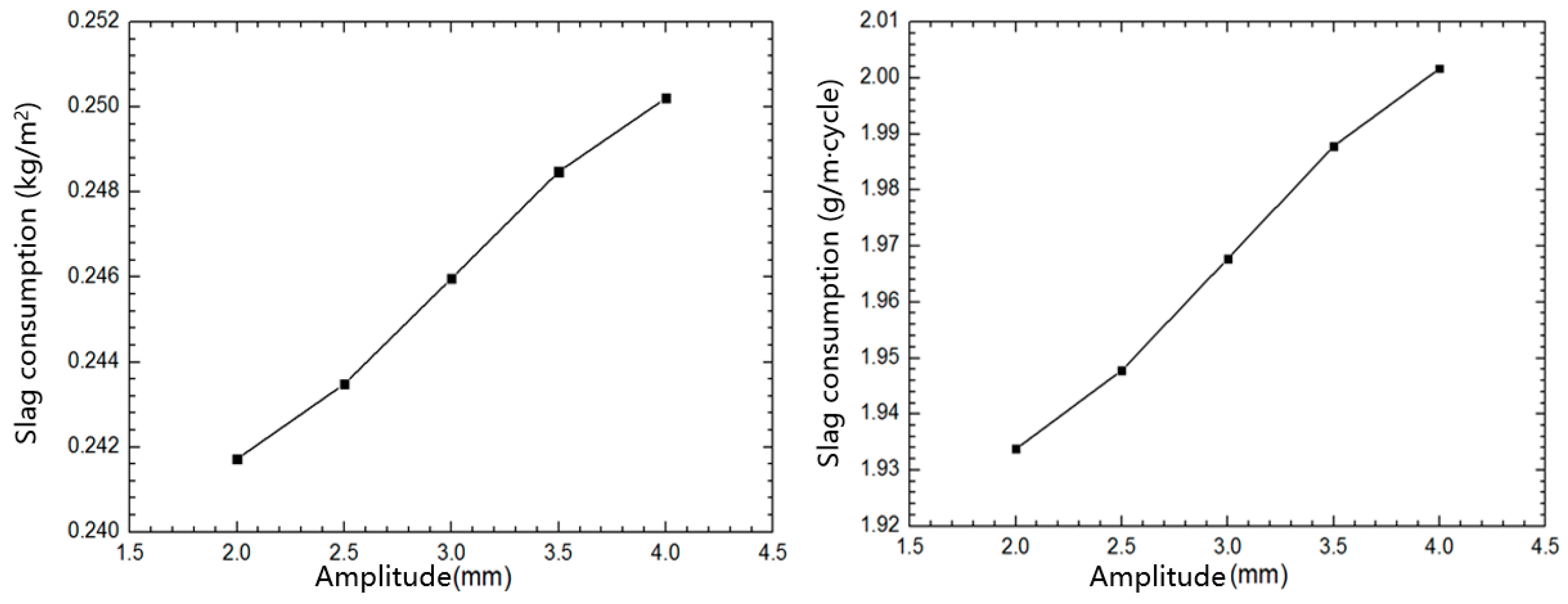Flow and Influencing Factors of Coated Slag in Continuous Casting Mold
Abstract
1. Introduction
2. Model
2.1. Governing Equation
2.1.1. Volume of Fluid Equation
- αst = 1. The unit is filled with liquid slag and there is no steel liquid present.
- 0 < αst < 1. The unit is a two-phase mixing zone.
- αst = 0. The unit is filled with molten steel without any slag.
2.1.2. Continuity Equation [16]
2.1.3. Momentum Equation
2.1.4. Turbulence Model [18]
2.1.5. Meniscus Contour Equation
2.2. Assumptions
- The flow of molten steel and protective slag is an incompressible steady-state flow.
- The natural convection caused by density is ignored.
- Due to the small calculation area of the model, the thickness of the slag film and the initial shell remain unchanged.
- The flow of molten steel in the meniscus area is mainly influenced by the casting speed and the flow of protective slag.
- The gap between the casting billet and the mold is filled with liquid slag, the flow velocity of liquid slag perpendicular to the drawing direction is ignored.
2.3. Boundary Condition
- Upper surface of protective slag: Pressure inlet boundary with a pressure value of 1 atm.
- Gap outlet: Pressure outlet boundary with a pressure value of 1 atm.
- Mold wall: Sinusoidal vibration.
- Initial solidification shell: Move at the casting speed.
- Right boundary of the model: No-slip boundary with an isotropic velocity of 0. It is set as a symmetric boundary.
3. Results and Discussion
3.1. Flow Velocity of Protective Slag on the Cross Section of the Slag Channel
3.2. Average Flow Velocity of Protective Slag
3.3. Calculation Method of Slag Consumption
3.4. Discussion on Factors Affecting the Consumption of Protective Slag
3.4.1. Influence of Casting Speed on Slag Consumption
3.4.2. Influence of Amplitude on Slag Consumption
3.4.3. Influence of Frequency on Slag Consumption
4. Conclusions
- The inflow and outflow states of protective slag on the cross-section of the slag film are related to the vibration parameters of the mold and the casting speed. During the positive slip period, there is a reflux of protective slag. During the negative slip period, the protective slag continues to flow into the gap. When ,the inflow and outflow of protective slag in the gap reach a balance. When ,the average flow rate of liquid slag is negative and will flow downwards into the gap between the mold and the shell. When the mold vibrates downwards at its maximum speed, the flow velocity reaches its maximum value. When , the outflow of protective slag is higher than the inflow, the contribution to slag consumption is negative, indicating non-slag consumption time. The consumption of protective slag occurs from the end of positive slip to the early stage of the next positive slip state and includes the entire negative slip stage.
- As the casting speed increases, the consumption of protective slag per unit area decreases. When the casting speed increases from 1.2 m/min to 1.6 m/min, the casting speed increases by about 33.3% and the consumption of protective slag per unit area decreases by about 4.76%. However, the consumption of protective slag per unit casting length within a vibration week increases by about 26.98%.
- The consumption of protective slag per unit area and per unit billet length within a vibration cycle increases slightly with the increase of amplitude. The variation pattern of the consumption of protective slag with vibration frequency is not obvious.
Author Contributions
Funding
Institutional Review Board Statement
Informed Consent Statement
Data Availability Statement
Conflicts of Interest
References
- Zhao, P.; Li, Q.; Kuang, S.B.; Zou, Z.S. Mathematical modeling of liquid slag layer fluctuation and slag droplets entrainment in a continuous casting mold based on vof-les method. High Temp. Mater. Process. 2017, 36, 551–565. [Google Scholar] [CrossRef]
- Liu, Z.Q.; Li, L.M.; Li, B.K. Modeling of gas-steel-slag three-phase flow in ladle metallurgy: Part I. Physical modeling. ISIJ Int. 2017, 57, 1971–1979. [Google Scholar] [CrossRef]
- Xu, L.; Pei, Q.W.; Han, Z.F.; Wang, E.A.; Wang, J.Y.; Karcher, C. Modeling study of EMBr effects on molten steel flow, heat transfer and solidification in a continuous casting mold. Metall. Res. Technol. 2023, 120, 218. [Google Scholar] [CrossRef]
- Swain, A.N.S.S.; Ganguly, S.; Sengupta, A.; Chacko, E.Z.; Dhakate, S.; Pandey, P.K. Investigation of corner cracks in continuous casting billet using thermomechanical model and plant measurements. Met. Mater. Int. 2022, 28, 2434–2447. [Google Scholar] [CrossRef]
- Suzuki, M.; Nakamoto, M.; Tanaka, T.; Tsukaguchi, Y.; Mishima, K.; Hanao, M. Effect of sulfur in slag on dynamic change behavior of liquid iron/molten slag interfacial tension. ISIJ Int. 2020, 60, 2332–2338. [Google Scholar] [CrossRef]
- Yu, X.; Wen, G.H.; Tang, P.; Ma, F.J.; Wang, H. Behavior of mold slag used for 20mn23al nonmagnetic steel during casting. J. Iron Steel Res. Int. 2011, 18, 20–25. [Google Scholar] [CrossRef]
- Yang, H. A 1D analytical model for slag infiltration during continuous casting of steel under non-sinusoidal mold oscillation. Metals 2020, 10, 1389. [Google Scholar] [CrossRef]
- Chen, W.; Zhang, L.F.; Wang, Y.D.; Ji, S.; Ren, Y.; Yang, W. Mathematical simulation of two-phase flow and slag entrainment during steel bloom continuous casting. Powder Technol. 2021, 390, 539–554. [Google Scholar] [CrossRef]
- Liu, Z.Q.; Sun, Z.B.; Li, B.K. Modeling of quasi-four-phase flow in continuous casting mold using hybrid Eulerian and Lagrangian approach. MMTB 2017, 48, 1248–1267. [Google Scholar] [CrossRef]
- Wang, Q.; Wu, Y.M.; Qiu, S.T.; Zhao, P. Simulation of thermal insulation of top-surface slag layers in continuous casting mold. J. Iron Steel Res. Int. 2012, 18, 29–33. [Google Scholar] [CrossRef]
- Zhou, L.J.; Wang, W.L.; Liu, R.; Thomas, B.G. Computational modeling of temperature, flow, and crystallization of mold slag during double hot thermocouple technique experiments. MMTB 2013, 44, 1264–1279. [Google Scholar] [CrossRef]
- Bielnicki, M.; Jowsa, J. Physical modeling of mold slag entrainment in continuous steel casting mold with consideration the impact of mold powder layer. Steel Res. Int. 2018, 89, 1800110. [Google Scholar] [CrossRef]
- Wang, L.L.; Zhang, Y.Z.; Long, Y.; Ke, H.B. Simulation of primary breakup of molten slag in the gas quenching dry granulation process. Appl. Therm. Eng. 2020, 25, 115850. [Google Scholar] [CrossRef]
- Zhang, L.L.; Chen, D.F.; Long, M.J.; Chen, H.B.; Huang, Y.W.; Dong, Z.H. Study on the fluid flow in a semi-open-stream-poured beam blank continuous casting mold with submerged refractory funnels by multiphase modeling. Metals 2016, 6, 104. [Google Scholar] [CrossRef]
- Li, L.M.; Liu, Z.Q.; Cao, M.X.; Li, B.K. Large eddy simulation of bubbly flow and slag layer behavior in ladle with discrete phase model (DPM)-volume of fluid (VOF) coupled model. JOM 2015, 67, 1459–1467. [Google Scholar] [CrossRef]
- Zhang, X.W.; Jin, X.L.; Wang, Y.; Deng, K.; Ren, Z.M. Comparison of standard k-ε model and RSM on three dimensional tur-bulent flow in the SEN of slab continuous caster controlled by slide gate. ISIJ Int. 2011, 51, 581–587. [Google Scholar] [CrossRef][Green Version]
- Brackbill, J.U.; Kothe, D.B.; Zemach, C. A continuum method for modeling surface tension. J. Comput. Phys. 1992, 100, 335–354. [Google Scholar] [CrossRef]
- Menter, F.R. Two-equation eddy-viscosity turbulence models for engineering applications. AIAA J. 1994, 32, 1598–1605. [Google Scholar] [CrossRef]
- Bikerman. Phisical Surfaces; Acadamic Press: London, UK, 1970. [Google Scholar]
- Ramirez-Lopez, P.E.; Lee, P.D.; Mills, K.C. Explicit modelling of slag infiltration and shell formation during mould oscillation in continuous casting. ISIJ Int. 2010, 50, 425–434. [Google Scholar] [CrossRef]
- Meng, X.N.; Zhu, M.Y. Analysis of liquid flux consumption mechanism for slab continuous casting mold with high casting speed. Acta Metall. Sin. 2009, 45, 485–489. [Google Scholar] [CrossRef]
- Zhu, L.G.; Jin, S.T. Numerical calculation on the flowing behaviour of mold fluxes between mold and shell. J. Iron Steel Res. 1998, 10, 9–12. [Google Scholar] [CrossRef]
- Shin, H.J.; Kim, S.H.; Thomas, B.G.; Lee, G.G.; Park, J.M.; Sengupta, J. Measurement and prediction of lubrication, powder consumption, and oscillation mark profiles in ultra-low carbon steel slabs. ISIJ Int. 2006, 46, 1635–1644. [Google Scholar] [CrossRef]
- Okazawa, K.; Kajitani, T.; Yamada, W.; Yamamura, H. infiltration phenomena of molten powder in continuous casting derived from analysis using Reynolds equation: Part 1: Steady analysis. ISIJ Int. 2006, 46, 234–240. [Google Scholar] [CrossRef][Green Version]
- Saraswat, R.; Fox, A.B.; Mills, K.C.; Lee, P.D.; Deo, B. The factors affecting powder consumption of mould fluxes. Scand. J. Metall. 2004, 33, 85–91. [Google Scholar] [CrossRef]






| Item | Value | Unit |
|---|---|---|
| Density of steel | 7000 | kg/m3 |
| Viscosity of steel | 0.0063 | Pa·s |
| Density of liquid slag | 2500 | kg/m3 |
| Viscosity of liquid slag | 1.1 | Pa·s |
| Frequency | 150 | cpm |
| Amplitude | 3.18 | mm |
| Interfacial tension | 1.3 | N/m |
| Number | Speed (m/min) | Frequency (cpm) | Amplitude (mm) | Slag Consumption (Kg/m2) | Slag Consumption (g/m·cycle) |
|---|---|---|---|---|---|
| A-1 | 1.2 | 150 | 3 | 0.2460 | 1.968 |
| A-2 | 1.3 | 150 | 3 | 0.2439 | 2.114 |
| A-3 | 1.4 | 150 | 3 | 0.2410 | 2.249 |
| A-4 | 1.5 | 150 | 3 | 0.2380 | 2.380 |
| A-5 | 1.6 | 150 | 3 | 0.2342 | 2.499 |
| B-1 | 1.2 | 120 | 3 | 0.2472 | 2.472 |
| B-2 | 1.2 | 130 | 3 | 0.2455 | 2.266 |
| B-3 | 1.2 | 140 | 3 | 0.2445 | 2.096 |
| B-4 | 1.2 | 160 | 3 | 0.2485 | 1.864 |
| C-1 | 1.2 | 150 | 2 | 0.2417 | 1.934 |
| C-2 | 1.2 | 150 | 2.5 | 0.2434 | 1.948 |
| C-3 | 1.2 | 150 | 3.5 | 0.2485 | 1.988 |
| C-4 | 1.2 | 150 | 4 | 0.2502 | 2.002 |
Disclaimer/Publisher’s Note: The statements, opinions and data contained in all publications are solely those of the individual author(s) and contributor(s) and not of MDPI and/or the editor(s). MDPI and/or the editor(s) disclaim responsibility for any injury to people or property resulting from any ideas, methods, instructions or products referred to in the content. |
© 2023 by the authors. Licensee MDPI, Basel, Switzerland. This article is an open access article distributed under the terms and conditions of the Creative Commons Attribution (CC BY) license (https://creativecommons.org/licenses/by/4.0/).
Share and Cite
Du, F.; Wang, S.; Zheng, G. Flow and Influencing Factors of Coated Slag in Continuous Casting Mold. Coatings 2023, 13, 1693. https://doi.org/10.3390/coatings13101693
Du F, Wang S, Zheng G. Flow and Influencing Factors of Coated Slag in Continuous Casting Mold. Coatings. 2023; 13(10):1693. https://doi.org/10.3390/coatings13101693
Chicago/Turabian StyleDu, Fengming, Shanjiao Wang, and Gengtao Zheng. 2023. "Flow and Influencing Factors of Coated Slag in Continuous Casting Mold" Coatings 13, no. 10: 1693. https://doi.org/10.3390/coatings13101693
APA StyleDu, F., Wang, S., & Zheng, G. (2023). Flow and Influencing Factors of Coated Slag in Continuous Casting Mold. Coatings, 13(10), 1693. https://doi.org/10.3390/coatings13101693





